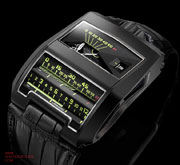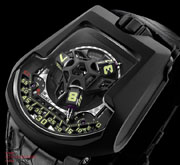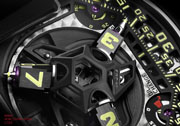

Urwerk
Les nouveautés 2010 des montres Urwerk (On en parle sur le forum)
UR-CC1 "Black Cobra "
La UR-CC1 nouvelle génération est le fruit d’une manipulation génétique réussie. Une mue soudaine a métamorphosé la carrure or gris de la « King Cobra » en noir, une teinte souvent signe de danger létal. En clonant sa UR-CC1 en couleur anthracite, l’équipe d’URWERK réaffirme l’agressivité de cette pièce et la pousse à son extrême.
Boîtier or gris traité AlTiN (Aluminium Titane Nitride), fond en titane
Particularités : dureté de l’or : 380 Vickers dureté du traitement AlTiN : 3800 Vickers
Données techniques, cliquez
The latest generation of the UR-CC1 is the result of successful genetic manipulation. A sudden shedding of the skin has transformed the grey gold "King Cobra" case into black, a colour often signalling lethal danger. In colouring the UR-CC1 anthracite, team URWERK reaffirms the aggressiveness of this piece, pushing the Cobra to the extreme.
Boîtier grey gold treated with AlTiN (Aluminium Titane Nitride), base in PE-CVD treated titanium
Particularities : hardness of gold : 380 Vickers hardness of AlTiN : 3800 Vickers
Technical data, clik here
UR-203
La UR-203 est une édition spéciale de 20 pièces, un délire mécanique mis à nue. Le spectacle se déroule sur l’avant scène et dans les coulisses. L’heure s’égraine entraînant pistons et roues dans son sillage.
« Cette UR-203 est une folie rêvée par Martin Frei (artiste et co-fondateur d’URWERK) », explique Felix Baumgartner, le maître horloger co-fondateur d’URWERK. « Il avait en tête un modèle ultra-dépouillé, réduit à sa plus pure essence. Il nous a fallu repartir de zéro pour concevoir ce modèle. Reprendre la planche à dessin et repenser totalement notre module. Le défi et la difficulté horlogère sont là, faire avec un minimum de pièces une complication fiable et stable ».
Carrousel, plots des heures, aiguilles télescopiques, cadran ont perdu 65% de leur poids en comparaison au modèle précédent (UR-202), la complication satellite affichant désormais un poids de 3,57 grammes.
Un indicateur « Oil change » et un « Odomètre horloger » sur 150 ans, indications originales mises au point par URWERK, viennent compléter le cadran squelette.
L’ « Oil change » informe le porteur de la UR-203 de la nécessité d’un service technique. Cette opération est recommandée après trois années de marche du mouvement.
L’ « Odomètre horloger », lui, calcule le nombre d’années de marche totale du mouvement. La UR-203 est également dotée d’un système inédit de remontage automatique régulé par une double turbine.
Les turbines, montées sur rubis, sont couplées au rotor. Elles sont contrôlées par un levier à trois positions : « FREE », « SPORT » ou « STOP ». Ce choix décidera de la force de bridage du remontage automatique, la fréquence de la turbine pouvant atteindre à son pic 16’500 tours/min.
"This UR-203 is a wild idea of Martin Frei (URWERK co-founder and designer)", explains Felix Baumgartner, URWERK co-founder and master watchmaker. "Martin imagined a stripped down model distilled to its pure essence. We had to start again at the beginning to develop this model, we sat down at the drawing board and completely reconsidered the satellite module.
The horological challenge with this complication was to develop a complex mechanism with the minimum of components to ensure its reliability and longevity." The carousel, hour satellites, telescopic minute hands and dial weigh 65% less than the proceeding model (UR-202). The satellite complication now tips the scales at a feather-light 3.57 grams.
An «Oil Change» indicator and a «Horological Odometer» spanning 150 years complete the open dial, both original URWERK developments. The «Oil Change» indicator informs the wearer when a service is due; an operation recommended every three years of movement operation. Similar to the odometer of a car, the UR-203's «Horological Odometer» keeps track of the total number of years of operation of the movement.
The UR-203 is also equipped with an innovative automatic winding system that is regulated by URWERK's double turbine system. The turbines are mounted on rubies and are controlled by a three-position lever offering the choice of « FREE », « SPORT » or « STOP ». The position determines the force available from the automatic rotor to wind the mainspring.


